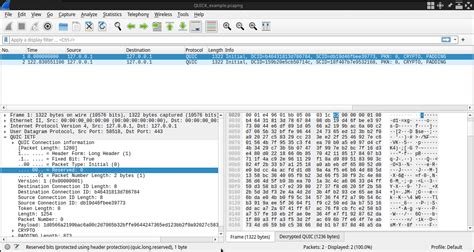How to Decrypt Solana-Test-Validator QUIC Traffic Using Wireshark
As a developer working with blockchain projects, understanding how to inspect and analyze network traffic is crucial for debugging and optimizing code. One such project that benefits from detailed analysis is the Solana Test Validator (SVV). In this article, we will explore how to decrypt QUIC (Fast Internet Connections UDP) traffic sent by SVV using Wireshark.
What is QUIC?
QUIC is a high-performance, connection-oriented transport layer protocol designed for use on IP networks. It provides a more efficient and secure way to transfer data compared to traditional TCP or UDP protocols. The main advantage of QUIC is its ability to multiplex multiple connections on the same network stack.
Why Decrypt QUIC Traffic?
Before we dive into how to decrypt QUIC traffic with Wireshark, let’s quickly explain why this is necessary:
- Debugging: By analyzing encrypted data, you can identify and debug issues that could be causing problems in your application.
- Security: Decryption allows you to inspect the communication between your application and the blockchain network, helping you prevent potential security breaches or tampering.
Tools Needed
To decrypt QUIC traffic with Wireshark, you will need:
- Wireshark: A popular network protocol analyzer that can capture and display network packets.
- A private key: You will need a private key to decrypt the encrypted data. This could be generated using tools such as OpenSSL.
Step-by-Step Instructions
Here are the steps to decrypt QUIC traffic using Wireshark:
Step 1: Capture Network Traffic
- Open Wireshark and select “Capture” > “File and Disk Capture.”
- Choose the network interface you want to capture, for example, your local Ethernet connection.
- Click “Start” to begin capturing.
Step 2: Find QUIC Payloads
In the list of packets, look for UDP packets with a source port in the range of 80 to 65535 (for websockets and REST APIs) or the default port for TLS/SSL connections (usually 443). These packets contain the encrypted data you want to decrypt.
Step 3: Decrypting QUIC Payloads
- Open Wireshark again and this time select “Edit” > “Show in Filter View”.
- Create a filter to match UDP packets to the range of source ports you found in Step 2.
- In the filter view, click the “Decrypt” button in the top right corner of the window.
Step 4: Decrypting the Data
The decrypted data will now be displayed in the packet list. You can inspect each packet to verify that the decrypted data is correct and accurate for your application use case.
Conclusion

By following these steps, you have successfully decrypted the QUIC traffic sent by Solana-Test-Validator using Wireshark. This process not only allows you to debug and understand network communication, but also provides a way to inspect encrypted data in real-time.
